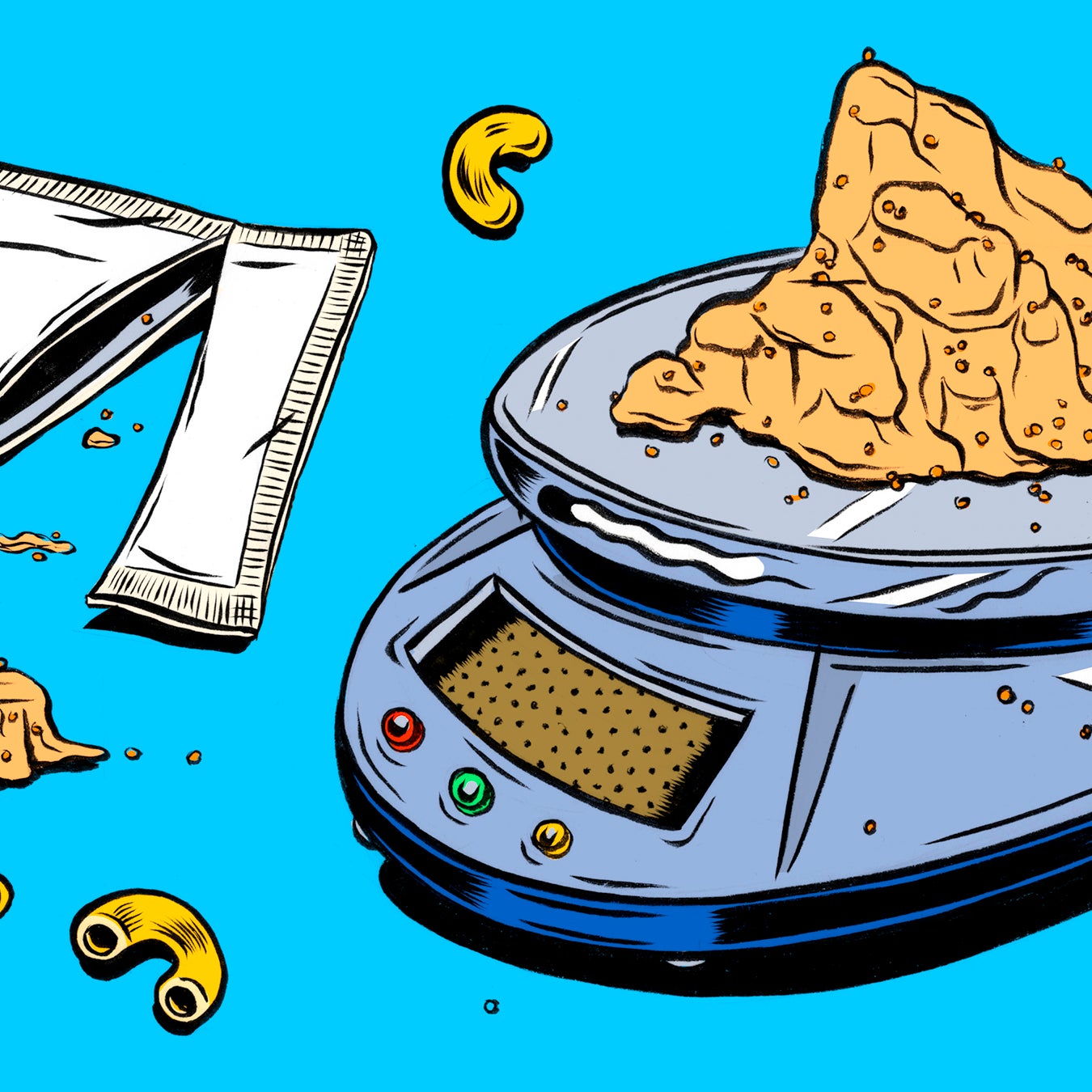At 7:00 on a cold January night, I turn on a portable electronic scale. I carefully pour the white powder onto the scale’s brushed-metal surface, watching the LED display flash to life. One gram, two grams, three, four…five grams. Perfect. I slide the fine powder off the scale and onto a bowl of gleaming spaghetti. Dehydrated mozzarella cheese dusts the crimson marinara sauce, like snow falling over a redrock desert.
I’ve spent 87 days weighing everything I eat, a nutrition regimen that, despite making me feel like equal parts cocaine kingpin and fitness-obsessed lunatic, has taught me more about weight management than I would have ever imagined.
I’ve always been a relatively fit guy. I work out at least four days a week—CrossFit, long trail runs, yoga, you name it—and I watch what I eat, sometimes even tracking calories. I’ve been called a Type A slacker, taking a Jeffrey Lebowski approach to the Tim Ferris lifestyle. And my casual method always seemed to work. At my last checkup, the doc said my health was great, and I’d finished in the top two percent of some decent-sized half marathons. Still, at 6’1″ and 185 pounds, I wasn’t as lean as I wanted to be. My BMI was on the higher end of what’s considered normal, and my hips often hurt after long runs. I wanted to see if shedding some weight might improve my fitness and help me look like Tyler Durden in the process.
Why I Started Weighing Food
I called Trevor Kashey, an Ohio-based registered dietitian who owns Relentless Dietetics. His suggestion was simple: weigh everything I eat. A lot of the Kashey’s clients are exactly like me, he said. They train hard and often, but they came to him because they were suddenly losing a step or not seeing the results they wanted in the mirror or in the gym. Diet is usually the problem, Kashey said. Nearly everyone radically underestimates serving sizes, especially in calorie-dense foods like oils, nuts, salad dressings, and nut butters.
Kashey is something of a diet prodigy. He got his BS at age 17, and his PhD in molecular biology at 23. And his methods apparently work. His Facebook page features dozens of before-and-after photos from clients to prove it. I was happy to let him be the brains of my nutrition.
I’ve been called a Type A slacker, taking a Jeffrey Lebowski approach to the Tim Ferris lifestyle.
For my first week, Kashey instructed me to eat my normal diet but to measure everything. On day one, I take a banana out of the freezer to make the same breakfast smoothie I’ve had every morning for the past half-decade. This time, though, I first place the banana on the scale: 130 grams. Next, I fire up MyFitnessPal, a free calorie-counting app that includes the USDA-verified nutritional stats of thousands of foods. I select “banana” and type in its weight in grams. I repeat this with almond milk, frozen blueberries, yogurt, walnuts, and protein powder.
When my wife walks in, I try to explain this new nutrition program. “That sounds exhausting,” she replies. Indeed. It takes me twice as long to make breakfast, and I wonder if this project is going to feel like a part-time job. At lunchtime, though, I become enlightened.
Like breakfast, I always eat the same lunch: a protein shake and a sliced apple with a serving of peanut butter. It tastes good and takes no time or effort to prepare, and I always figured it was a smart choice, delivering around 500 calories and a nice balance of carbs, fat, and protein. But when I weighed my peanut butter, I realized that what I had always assumed was one serving was actually three, or about 600 calories. My “light lunch” delivered the calorie equivalent of a BigMac and medium fries. “When you learn how much a serving of peanut butter actually is,” Kashey later told me, “it is completely soul crushing.”
There were more depressing lessons at dinner. I learned that those little snacks I munch on as I cook—a few carrots with hummus here, a cracker there, a piece of cheese for good measure—add an extra 300 calories. My chicken breast is nine ounces, not six. My potato has 279 calories, not the 100 I’d always assumed, and, of course, it takes way more than one serving of sour cream to cover a baked potato.
“When you learn how much a serving of peanut butter actually is, it is completely soul crushing.”
After week one, I send in my data, and Kashey gives me a new daily calorie and protein goal: about 2,500 and a little more than 130 grams, respectively. From now on, I’d use the scale to hit those numbers and weigh myself every morning. Each morning, I’d pull out the and pour exactly one serving, or 30 milliliters, of half-and-half into my mug of coffee. At lunch, I’d weigh my apple and the one serving—32 grams—of peanut butter to slather atop it. At dinner, I’d work the scale overtime, measuring my cooked chicken breast, baked potatoes with sour cream, and mixed vegetables. I was using my food scale as much as my cellphone.
At the end of each week, the food data would again get sent to Kashey, along with my daily scale weight and progress pictures. He’d crunch the data, then raise my protein target and calorie load by 30 to 50 daily calories a week. “I’m looking for the amount of food where your weight stabilizes,” he said. “When you begin accurately measuring, you inevitably lose weight. Once we know the amount of food you stabilize at, then we can decide if we want you to gain or lose by tweaking that number.”
Slowly, the weight started to come off. Half a pound one week, a pound the next. Four months in, my weight settled at around 173—a loss of more than ten pounds. And we now had a daily calorie goal to keep my weight stable: about 2,950.
Kashey’s plan was not easy. Some meals were quick and easy to measure, like my lunch of apples and peanut butter. More complicated recipes, however, required a mathematician’s mind. I’d have to determine exactly how many servings I was using of each ingredient, add all those numbers to determine the entire dish’s caloric load, and then calculate how much of the dish I ate and divide.
Weighing food also makes people think you’re a crazed narcissist. My office mates squirmed when I stopped eating cake at office parties (I didn’t want to do the math), and friends began to resent me for my supposed self-control. Instead of being present, chatting, and enjoying a meal, I was logging data. It also became a spontaneity killer. If I was going out to dinner with my wife, I had to know the restaurant’s exact hours beforehand so I could visit its website and figure out the calories in what I planned to order. I began thinking of food as a plug-and-chug numbers game rather than a pleasurable universal necessity humans share and enjoy together.
That said, it was worth it. After a few months on the plan, I’d lost more than ten pounds. I’m now the leanest I’ve ever been, and my fitness has exploded. For years, my hips had ached after any run longer than five miles. Shedding the weight means less overall stress on my joints. My pain is gone no matter how long I run, and I’m running faster at a lower heart rate. In the gym, I’m just as strong as I was before I started, which means I’m stronger pound for pound.
I want to weigh my food for the rest of my life as much as I want to mow the lawn every day. Four months was enough. (Just ask my wife.) But through Kashey’s plan, I learned a few important lessons about food that will surely linger and help me stay lean and fast for the long haul.
Those Little Things You Eat Add Up
When I used to get home from work, I’d typically graze around the kitchen as I prepared my dinner. I thought things like cheese and chips and salsa were harmless, insignificant snacks to tide me over before dinner—until I started logging them. Some nights those mindless appetizers packed in more than 400 calories.
Not All Calories Are Created Equal
Fad diets will have you believe that to lose weight you need to cut out certain food groups, macronutrients like carbs, or just “eat clean” (whatever that means). But research consistently shows that weight loss lives and dies with simply burning more energy than you’re consuming. In other words, it doesn’t really matter what you eat so long as you’re eating less energy than you burn, says Kashey. If you keep your calories below threshold, you could technically lose weight on a diet of Skittles, pizza, and Big Macs and still lose weight. (Would it be healthy, though? Definitely not.) Throughout this experiment, I ate a nightly bowl of Lucky Charms with whole milk. I also ate foods like burgers, peanut butter and jelly sandwiches, and peanut M&M’s.
The key, as with all diets, is moderation. Those foods won’t fill you up, and they pack in more calories. Foods we consider healthy—vegetables, fruits, lean meats—are filling but contain fewer calories compared to processed foods. If you can feel full on fewer calories, you’re more likely to go into a calorie deficit, or the state where you’re burning more energy than you’re consuming.
Potatoes Are Miracle Workers
In the mid-1990s, researchers in Australia set out to determine which foods are the most filling. They created a metric called the “satiety index” and found that potatoes ranked highest, which is exactly why I ate potatoes five nights of the week.
A couple small potatoes at dinner keep me full until morning and contained just a couple hundred calories. Potatoes are such an effective weight-loss tool that magician Penn Gillette lost 73 pounds after eating only potatoes for 83 days.
Finding Go-To Meals Is Key
After a couple weeks on my plan, I’d settled into a routine, finding a right-size breakfast, lunch, and a few dinners that I’d eat most days of the week. This made my life easier, removing much of the tedious thinking and planning that went every ounce of food. Now that I’m phasing off the plan, I’ll still take the same approach. By having a handful of healthy go-to meals, you can better control what you eat.
Eat “Enough” Food
I’d always viewed weight management as a matter of eating more food or less food. Kashey says a better way to look at it is to eat enough food. Enough isn’t too little or too much; the former leaves you underfueled, while the latter adds pointless pounds. Enough, on the other hand, is the sweet spot that leads to an ideal weight. Kashey, for example, has worked with men and women who were overweight because they were eating too little, which resulted in frequent binges. A regular bump in healthy calories gave them fuel to exercise harder and kept them satiated for longer.


